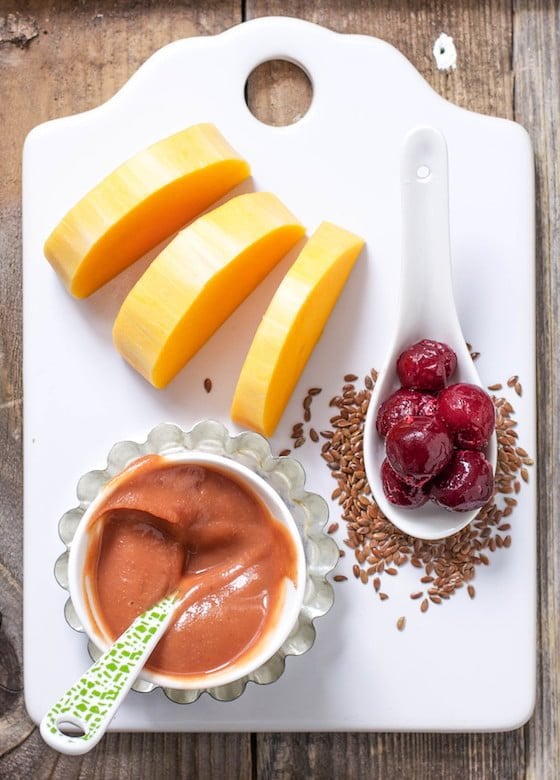Baby Led Weaning: A Real Food Approach to Feeding Your Baby
Baby led weaning allows your baby to take the lead when foods are introduced, letting her learn to feed herself from the start.With a new baby, every new phase can be exciting but also pretty stressful.
Learning new cues, figuring out a feeding schedule…it’s a bit daunting. Then, once you finally get your feeding routine under control, what happens?

Time for “solids.”
The idea of starting baby off at the age of four months with purees is one way to go, and quite possibly the way you yourself were raised. But, today several health organizations are actually advising that parents wait until baby’s system is more mature, closer to 6 months.
And when it’s time to introduce new options into baby’s diet, why not try baby-led weaning?
What is baby-led weaning?
What’s baby led weaning, you ask? The name is a little misleading; it doesn’t mean that it’s a way to get baby to quit nursing or taking formula. Rather, it’s the term first coined by Gill Rapley and Tracey Murkett in their book Baby-Led Weaning: The Essential Guide to Introducing Solid Foods, referring to a supplement to breast (or bottle) that offers baby soft pieces of food to consume by “self feeding.”
This method allows babies to develop age appropriate oral motor control and gives them a positive, interactive early food experience.
Rather than offering spoonfuls of pureed fruits, veggies, and cereals, you can pick from a wide range of foods to offer your little one, oftentimes in conjunction with what the rest of the family is eating. Baby will freely learn how much food to eat and how quickly, and is given the chance to decide when she wants to transition to less milk/formula and more solids (usually later in her first year).
Should you let your baby lead the way on solid foods?
So, why would you want to give BLW a try? Many find the experience much less stressful (for parents and child) and even easier since parents are able to sit and enjoy a meal rather than taking breaks to spoon feed the baby. This method also offers a wide range of flavors and textures to allow baby to discover an appreciation for many types of foods early on.
What about choking?
Since it is a new method for many parents, the first concerns are often with regards to choking. It’s totally a legitimate fear, but as long as you offer properly-sized, soft pieces of food (and avoid the foods on the “don’t try” list below), you may be surprised at how well your child takes to the process.
Of course, it’s always advised to watch baby while they eat and be sure to make a sweep of her mouth if you see any signs of choking. It’s also good to recognize the difference between a natural gag reflex (which is designed to naturally bring a too-large piece of food from the throat and back of the mouth forward to avoid choking) and real choking.
If your baby is gagging, her eyes may water, she may cough, sputter, make gagging sounds, be silent yet intently moving food toward the front of her mouth, or may look afraid. Choking, though, is when an object or substance becomes stuck in the throat or windpipe, causing the blockage of airflow.
In their new book Born to Eat: Whole Healthy Foods from Baby’s First Bite, co-authors Leslie Schilling and Wendy Jo Peterson advise that is your baby is choking, it’s unlikely she’ll be able to make sounds and will not be able to effectively move air. When infants are eating while reclined, they’re at greater risk for choking, so always make sure your baby is sitting upright during feeding.
When should you start baby led weaning?
When should you start baby-led weaning? Your child may start showing signs that it’s time to try around 6 months of age. Katja Leccisi, nutritionist behind Leccisi.com and the soon-to-be-published book Questions and Answers About Your Baby’s First Foods, suggests that your baby is developmentally ready to start eating foods when she has fairly good head control, can more or less sit up and lean forward by herself, and can reach for things and bring them to her mouth.
“He may also show an interest in what is on your plate,” she explains. “For most babies, this will be when she is close to 6 months old, but some may be ready earlier.”
Leccisi also says that it helps to let your baby try and feed herself. “Even if you are offering your baby foods by spoon feeding him, give him the opportunity to learn to feed himself. If your baby is six months old when you start introducing foods to him, he will probably be very happy to have some food on the tray in front of him to pick up and eventually eat. First foods are all about discovery, so give him plenty of opportunities to explore foods.”
Tips for baby led weaning success
Start small… but not with the food. Pick one food at a time and try it for a few days to get baby used to the new flavor and to give you time to observe whether there is an allergic reaction. Only offer one piece at a time and place it right on their tray so that they focus on one thing at a time. While some advise giving baby smaller pieces, it’s actually easier for them to grasp at soft-cooked pieces of food that are about the length of your thumb.
Solid doesn’t mean HARD. If a food is able to be smushed between two of your fingers, it’s most likely okay for your child to try eating. While some advise offering solid apples for baby to suck on, if you’re wary to try it, cook it down a bit and allow to cool before offering.
Expect a mess. This is an area that parents often grow frustrated with regards to spoon-feeding. Yes, this method WILL be messy. Food will most likely end up in baby’s hair, on clothes, and on the floor. If this sort of thing gets you upset, try stripping baby down to her diaper and making sure that the highchair is on a smooth surface (or throw a big tablecloth or shower curtain on the floor to make clean-up a bit easier). Or, just embrace it and grab the camera!
Don’t be afraid of flavor. We often offer super bland foods to babies. Why? As your child gets the hang of eating, sprinkle a little cinnamon on that apple chunk or some cumin in with their ground meat. Adventurous eating starts early, and the addition of spices helps.
A happy baby is better at discovery. We’ve all experienced the symptoms of being hangry, right? Well, so do babies. Don’t wait for your child to be super hungry to offer solids. Waiting until partway between feedings will set them up for a much more relaxed, fun food experience.
Don’t hope for perfection. As with all milestones, it takes some children longer to get the hang of a new skill than others. If your child is having a hard time with her pincer grasp, cut the food a little longer for easier grabbing. If she only likes to pick up the food and play with it or apprehensively lick at it, that’s okay. As long as she’s still getting enough milk in her system, solids aren’t a big deal. This often begins as more of a tactile learning experience for children than a culinary one; they’ll get the hang of it when they’re ready.

BLW First foods
– Cooked carrot, sweet potato, potato, butternut squash, pumpkin, zucchini, apple, broccoli, green beans (with skins removed)
– Slices/chunks of raw, ripe banana, avocado, peach, pear, melon, strawberries
– Cooked meat or poultry
– Cooked egg
– Whole wheat bread, cooked pasta, brown rice
Foods to avoid
– Processed meats
– Raw meats
– Raw eggs
– Raw fish
– Honey
– Unpasteurized milk and milk products
– Unpasteurized juices
– Stimulants (like sugar and chocolate)
– Added sugar or table salt
– Any foods that could pose as a choking hazard, including but not limited to: hard candies, chewing gum, popcorn, marshmallows, nuts/seeds, fish with bones, hotdogs/sausages, grapes (unless cut lengthwise)
– There is no evidence that waiting on introducing highly allergenic foods (such as seafood, citrus, peanut butter) has long-term benefits. As with all foods, keep a close eye on your child for any allergic reaction, but there is no need to hold back on introducing a variety of foods at six months and beyond.
As always, discuss your concerns with your doctor if you see signs of an allergy.
